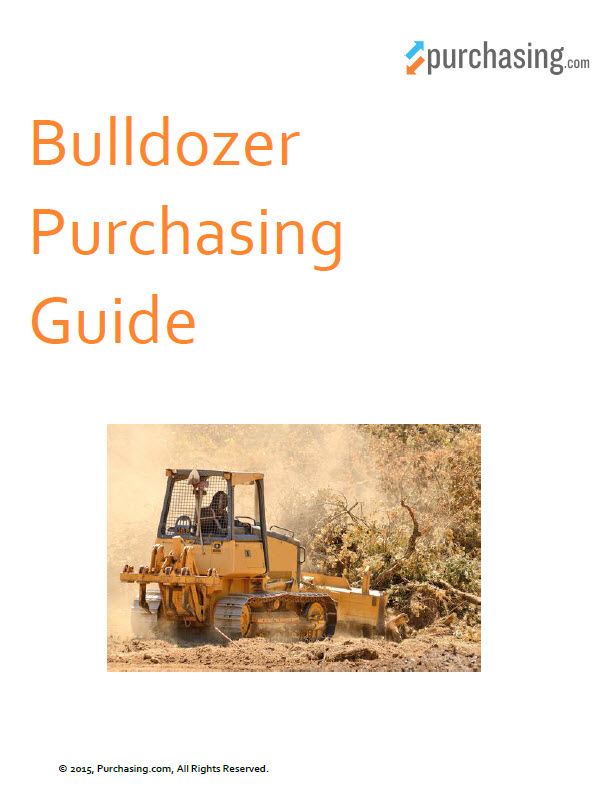Introduction to the Bulldozer Buying Process
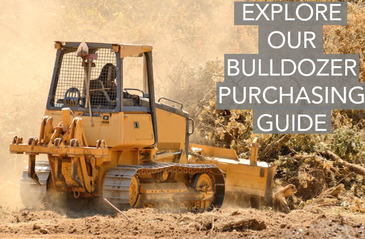 Table of Contents
Table of Contents
- Introduction
- Trends
- Types
- Specs
- Attachments
- Choosing a Dealer
Introduction
Modern bulldozers have come a long way since their inception in the early 1900s. Now incorporating a wide range of automated monitoring features, hydraulic systems, and ergonomic joystick controls, they are capable of productivity unimaginable just a few decades ago.
In general, there are three main sizes: small, medium, and large. Broken down by power output, weight class, and even the size of their blade, machines in these three categories tend to fall within the range below:
[table]
Size, Horsepower, Operating Weight, Estimated Cost
Small, 80 hp, "17,500 lbs.", "$64,000 - $90,000"
Small, 92 hp, "18,000 lbs.", "$83,000 - $125,000"
Medium, 130 hp, "29,300 lbs.", "$160,000 - $295,000"
Medium, 205 hp, "46,160 lbs.", "$170,000 - $340,000"
Large, 600 hp, "155,000 lbs.", "$400,000 - $1,200,000"
Large, 850 hp, "230,000 lbs.", "$600,000 - $1,300,000"
[/table]
A fourth category, waste handling bulldozers, also exists. It includes a limited number of machines that are highly resistant to debris and designed primarily for landfills and refuse centers.
Purchasing considerations
Leading manufacturers include John Deere, Caterpillar, Komatsu, Liebherr, and Bobcat. Together they produce two main types: crawler (operating on tracks like a skid steer) and wheel-based (equipped with heavy-duty, all-terrain tires like those found on a rough terrain forklift). But given the average operating environment that requires a bulldozer, the split between the two types is anything but equal.
Crawler bulldozers are far more prevalent than their wheeled counterpart. In fact, a quick analysis of the total number of models available on the market - both new and used - reveals a split of 105:1 in favor of the track-based crawler design. That said, there are circumstances that require a wheel-type bulldozer, and we'll address them later in this guide.
Bulldozer benefits
Bulldozers have become a multi-purpose cornerstone to private enterprises and governmental organizations alike due to their primary attachments: the blade and the ripper. Basic yet highly functional, they are used throughout an extensive range of industries, including agriculture, construction, city planning and management, and landscaping. They save countless hours that would otherwise be spent on manual labor, mechanizing tasks that include:
|
|
This Bulldozer Purchasing Guide covers the latest types, specs, and attachments as well as what to look for in a quality dealer. But before we get into the hard numbers, it's important to consider one of the biggest trends in heavy equipment - new or used? - as this is often the first question you'll ask yourself when comparing models. Let's get started.
Back to top
Trends
Businesses across the spectrum are always looking for ways to cut costs and remain competitive. On many jobsites, one of the most common means of achieving this goal is to purchase used equipment. A recently manufactured used bulldozer provides much of the same technology for 30% to 70% less than the price of a comparable new machine.
But investing in a used bulldozer doesn't suit every application. Here's a quick rundown on the pros and cons of new and used equipment, as well as the industries and applications each is best suited to.
New bulldozers
From refuse centers and general construction to forestry and agriculture, bulldozers are largely responsible for the greatest volume of materials handling on any given jobsite. For this reason, they are engineered for efficiency and productivity within specific applications. The good news is: with proper service and maintenance, they run for decades.
The following are a few pros and cons:
 New technology: Machinery and its electronic components are continuously advancing. In the bulldozer category this translates to increased fuel efficiency, better real-time monitoring, improved emissions, and advances in cab comfort and ergonomic design. These improvements not only make them easier, safer, and more comfortable to operate, they also increase their productivity, lowering the cost of ownership while making them more cost-effective on every job.
New technology: Machinery and its electronic components are continuously advancing. In the bulldozer category this translates to increased fuel efficiency, better real-time monitoring, improved emissions, and advances in cab comfort and ergonomic design. These improvements not only make them easier, safer, and more comfortable to operate, they also increase their productivity, lowering the cost of ownership while making them more cost-effective on every job.
 Customizable Large-scale operations tend to work in extreme environments. Whether it's dramatic temperatures and unforgiving weather or rough terrain and remote locations, a new bulldozer can be built with specific modifications that meet an endless variety of specifications. In this way, a new machine may be more productive as it's been designed for a specific application. This includes both the mechanical features as well as specific attachments.
Customizable Large-scale operations tend to work in extreme environments. Whether it's dramatic temperatures and unforgiving weather or rough terrain and remote locations, a new bulldozer can be built with specific modifications that meet an endless variety of specifications. In this way, a new machine may be more productive as it's been designed for a specific application. This includes both the mechanical features as well as specific attachments.
 Warranty coverage: A new bulldozer is typically backed by at least a one-year warranty, with optional coverage provided direct through the manufacturer that can extend the initial warranty up to three years or 10,000 hours (monthly fee/deduction applies). This coverage travels with the machine wherever it's in operation. So from jobsite to jobsite, you're protected against defects in material or workmanship.
Warranty coverage: A new bulldozer is typically backed by at least a one-year warranty, with optional coverage provided direct through the manufacturer that can extend the initial warranty up to three years or 10,000 hours (monthly fee/deduction applies). This coverage travels with the machine wherever it's in operation. So from jobsite to jobsite, you're protected against defects in material or workmanship.
 Pricey : A new bulldozer represents a serious investment. Looking at a new mid-range model, one that offers 335 hp, you can expect to pay $180,000 to $340,000 depending on the brand and any additional customizations. This outlay is not viable for many small to mid-range businesses without financing and may even represent more of a financial risk for this type of buyer in the event of economic fluctuation.
Pricey : A new bulldozer represents a serious investment. Looking at a new mid-range model, one that offers 335 hp, you can expect to pay $180,000 to $340,000 depending on the brand and any additional customizations. This outlay is not viable for many small to mid-range businesses without financing and may even represent more of a financial risk for this type of buyer in the event of economic fluctuation.
Used bulldozers
Despite their extreme usefulness, bulldozers are one of the most expensive pieces of heavy machinery you can buy. This has led some business owners and managers to rent or lease their equipment to supplement an existing fleet or accommodate a short-term contract. But these setups may not always be financially beneficial in the long term. So many are now turning to used bulldozers for their overall value.
The following are a few pros and cons:
 Substantially less expensive: On average, a used bulldozer can be found for 30% to 70% less than a new machine. To revisit the example used in the 'new' category above, a similar mid-range model with around 300 hp and between 1,900 and 5,000 hours on its hour meter can go for $45,000 to $160,000. It's important to note that major attachments may also include hours of operation on many used listings. If the attachment is an important factor to you, make sure the one you're considering has a level of use relative to the machine.
Substantially less expensive: On average, a used bulldozer can be found for 30% to 70% less than a new machine. To revisit the example used in the 'new' category above, a similar mid-range model with around 300 hp and between 1,900 and 5,000 hours on its hour meter can go for $45,000 to $160,000. It's important to note that major attachments may also include hours of operation on many used listings. If the attachment is an important factor to you, make sure the one you're considering has a level of use relative to the machine.
 Reliable: Bulldozers are built to withstand extreme operation for decades. While each individual application will dictate the machine's ultimate longevity, they're reliable for at least 10,000 hours without any major repairs - and some a lot longer with proper service and maintenance. This lifespan enables a solid return on the initial investment.
Reliable: Bulldozers are built to withstand extreme operation for decades. While each individual application will dictate the machine's ultimate longevity, they're reliable for at least 10,000 hours without any major repairs - and some a lot longer with proper service and maintenance. This lifespan enables a solid return on the initial investment.
 Older technology: Used bulldozers are available with manufacture dates that go all the way back to the 1970s. But this isn't what we mean when referring to older technology. Newer used models with manufacture dates within the past 10 years provide many of the same developments in terms of joystick control and cab design as new models.
Older technology: Used bulldozers are available with manufacture dates that go all the way back to the 1970s. But this isn't what we mean when referring to older technology. Newer used models with manufacture dates within the past 10 years provide many of the same developments in terms of joystick control and cab design as new models.
They also comply with EPA standards for their particular engine type. Nevertheless, with operators increasingly used to the conveniences of the latest technology, an older machine may represent a problem for some. Plus, with models older than 10 years, you may not get a comparable level of fuel efficiency due to the improvements recently made to diesel engines, increasing the cost of operation in comparison to a newer machine.
Business recommendations
Used bulldozers are typically seen as the most solid investment within the farming and landscaping demographics, as well as for those who only plan on using the machine part-time. On the other hand, local and state governments, large construction or mining operations, and other companies that manage a fleet of machinery prefer new equipment for greater performance and efficiency.
Back to top
Types
Bulldozers are designed for particular uses. Some are even custom-tailored to the demands of specific industrial applications with productivity features that are geared toward construction, agriculture, landscaping, and waste handling. Despite the wide range of bulldozers and customizations available, there are only two types:
- Crawler dozers
- Wheeler dozers
The type classifications refer to the machine's method of locomotion. As the name implies, wheeler dozers are equipped with four heavy-duty, all-terrain tires that give it an advantage in certain work environments. Crawler dozers get around on tracks, similar to a track loader. This design provides a high degree of traction and safety in almost any terrain, making crawler dozers the more popular of the two - by far.
Crawler dozers
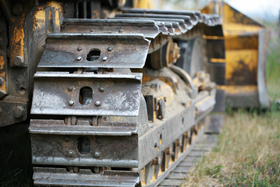 Similar in appearance to a tractor or skid steer, a crawler bulldozer is used for a variety of construction, agricultural, and landscaping applications. Its tracks enable it to traverse irregular, shifting terrain including fields, refuse piles, and large mounds of earth, gravel, or other material on a work site.
Similar in appearance to a tractor or skid steer, a crawler bulldozer is used for a variety of construction, agricultural, and landscaping applications. Its tracks enable it to traverse irregular, shifting terrain including fields, refuse piles, and large mounds of earth, gravel, or other material on a work site.
In addition to the tracks, its other distinguishing trait is a ripper - a large ground-breaking claw mounted onto the rear of the vehicle. This extends the machine's capabilities to a wider range of demolition and earth moving tasks, making it highly useful for breaking through concrete and other paved surfaces as well as frozen ground.
- NOTE: blades and rippers are detailed in the Attachments section of this guide.
Another major difference between the two is what's known as contact length. Contact length is the measurement of the amount of contact the machine has with the work surface. When comparing tires to tracks, the contact length of a tire is substantially shorter than that of a track, providing far less traction.
This won't make much difference when the machine is operated on something like sand due to the nature of frictional soil (which is largely dependent upon operating weight). But on a cohesive work surface like clay or packed soil, the track-based model will achieve far superior levels of traction due to its greater degree of contact with the work surface. This is why it enjoys such a wide level of adoption among an extensive range of heavy-duty industrial jobsites.
Wheeler dozers
Wheel dozers are similar in some aspects when compared to the track-based variety. For example, they are equipped to operate in a variety of work environments, moving a vast amount of material with a large blade mounted to the front of the machine. But there are some differences that make them better suited to some tasks than others.
First is their size. On the whole, wheel dozers are larger than crawler dozers, commonly starting out with outputs of over 200 hp and weighing more than 45,000 lbs. They often fall within the mid-range for this type of equipment. This is in comparison to crawler dozers that can be found with outputs of 80 hp and weigh little more than 17,000 lbs. The size and weight of a wheeler dozer make them ill-suited to costly grounds or paved surfaces, as well as work areas with tight, restrictive space. Plus, most do not come with a ripper - though there are some exceptions found in the largest wheeled models.
The other primary difference is the wheel dozer's hydraulic steering. Wheeled bulldozers move around on a small axis through fully articulated hydraulic steering. This gives them certain advantages in locations where tight turns are required and makes them popular for tasks related to facilities maintenance among corporate and college campuses, sports arenas, and similar locations with buildings and objects that require more exact positioning.
Back to top
Specs
Comparing specifications is one of the easiest ways to narrow the purchase field. If you're unsure of the exact specs required for your specific task, a qualified dealer will help. They will walk you through the process and advise you on the machines that are capable of providing the best combination of cost-effectiveness and productivity.
Here's a quick overview of the top specs related to bulldozers and a more in-depth review of some of the popular features. We get into more detail on rippers and blades in the Attachments section of this guide.
- Horsepower: 92 to 850 hp
- Max travel speed: 6.2 to 10 mph
- Operating weight: 18,000 to 230,000 lbs
- Ripper: 1 to 3 shanks with a common digging depth of 13 inches
- Blade width: 8.6 feet with a 2 yd3 capacity to 16.3 feet with a 15.3 yd3 capacity
Joystick controls
As with many other types of earth moving equipment, one of the most recent (and popular) additions to the bulldozer is joystick operation. Steering, direction, speed, and transmission are all controlled by an electro-hydraulic joystick that provides greater precision and maneuverability than previous generations.
Ergonomically-designed, many joystick models include differential steering, simplifying the navigation of corners and other tight areas. They also typically include a thumb roller to shift the transmission, a thumb rocker that controls both the blade and ripper (or other rear attachment), and a throttle rocker for manually adjusting the engine speed to high or idle - saving on unnecessary fuel consumption.
Cab design
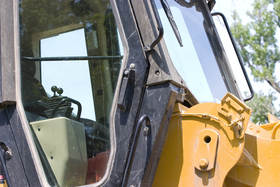 Also benefiting from ergonomics, cab enhancements are aimed at increased productivity through a more comfortable work environment. Modern cab designs feature an isolation-mounted pressurized environment with heavy-duty air filters and a greater degree of internal air pressure. This provides safety by greatly reducing the noise, dust, and vibration that result from operation. It also allows the operator to communicate easily and effectively with other operators or fleet managers.
Also benefiting from ergonomics, cab enhancements are aimed at increased productivity through a more comfortable work environment. Modern cab designs feature an isolation-mounted pressurized environment with heavy-duty air filters and a greater degree of internal air pressure. This provides safety by greatly reducing the noise, dust, and vibration that result from operation. It also allows the operator to communicate easily and effectively with other operators or fleet managers.
Visibility is another component of many redesigns, positioning the seat and controls to provide an unobstructed sightline through large glass panels that increase safety, speed, and performance. It's also worth noting that some models feature additional enhancements to the seat itself, enabling it to be adjusted with bolsters that prohibit side-to-side movement, thereby minimizing the otherwise jarring effects of operation.
And finally, air conditioning. Bulldozers are used in a range of extreme climates, making temperature control critical for safe, productive operation. Common units feature a 24,000 Btu output for the air conditioner, with additional enhancements like a 30,000 Btu under-seat heater also available.
Undercarriage
Unlike other types of heavy equipment, the undercarriage is often a consideration on bulldozers. Much of this is due to the environments and terrain within which they operate. Common undercarriage classifications include:
- Standard - A tough undercarriage well suited to landscaping, construction, and similar tasks, it isolates core components, including drive, axle, and steering modules, to prevent impact damage. Many standard undercarriages also include improvements to oil-seals to extend their life and durability.
- Heavy-duty - Including all the features of a standard undercarriage, this type increases the durability of all components to further resist abrasions and impact damage with enhancements like steel plating for maximum strength and idler rims that are finished with medium to low heat treating for extended life. This type is widely used within sloped, rocky, or similar rough terrain environments.
Before you purchase, know that not all undercarriages are created the same. Leading manufacturers, including CAT and John Deere, produce additional models that cater to soft terrain, swampy work environments, and applications that require fine grading.
Back to top
Attachments
Much of the heavy equipment sector is focused on adaptability and the universal coupling of a wide range of attachments. While bulldozers do accept multiple attachments, their primary strength is focused on the use of rippers and blades.
Rippers
Used to tear up packed earth, paved surfaces, frozen ground, and similarly impenetrable surfaces, a ripper is essentially a large talon mounted to the back of the bulldozer. They are widely used among agricultural and construction applications. Depending on your needs, rippers include 1 to 3 shanks with a common digging depth of 13 inches and are typically manufactured from high strength alloy steel. It's worth noting that single shanks often provide a deeper digging depth than multi-shank models.
- Expect to pay: $2,400 to $45,000 depending on the size of the attachment. Popular rippers for small to mid-range bulldozers start around $8,500.
Blades
The blade often represents a large portion of the purchase consideration when buying a bulldozer. It's essentially a heavy metal plate that's mounted to the front of the machine. Mainly tasked with the pushing of material including rock, sand, soil, and refuse, it's shaped in a variety of configurations, each of which is suited to a specific range of tasks. Sizes typically extend from 8.6 feet with a 2 yd3 capacity to 16.3 feet with a 15.3 yd3 capacity.
Within the bulldozer category, "standard" tends to mean different things when referring to blades, as each machine is engineered for productivity in a different way. Below is a rundown on each type of blade available, including popular specs and what you can expect to pay for each.
S Blade
This is the most common type of bulldozer blade. The straight blade, or S blade for short, is roughly shaped like a large rectangle. Used primarily for land clearing, finish grading, and pushing materials around a jobsite, an S blade is hydraulically controlled and can be tilted to dig - though digging depths are somewhat limited. The weight and geometry of an S blade enable it to reportedly perform best on jobsites with medium to compact materials such as clay and soil.
A straight blade often comes standard on small to mid-range machines. Many are capable of handling from 2 to 7 yd3 of material and digging depths of about 2 feet.
- Expect to pay: $2,500 to $6,000 for new and used blades in this category.
U Blade
Designed with greater height than an S blade, the U blade has a slight curve to it (resembling a relaxed U) and also includes spill plates on either end to keep materials contained within the width of the blade during operation. This type of blade was created for longer runs, enabling the bulldozer to push materials across a field or entire jobsite. As such, they are ideal for moving rocks and gravel, boulders, and chunks of concrete. But they also provide the highly efficient transfer of dirt and other soil over extended distances.
Similar to an S blade, the U blade is hydraulically controlled. It has tilt cylinders that allow it to perform moderate ground penetration tasks such as ditching and crowing, making it a popular choice for road maintenance and construction. You will find standard gauge blades in this category capable of moving 6 to 45 yd3 of material and supporting weights ranging from 3,000 to 19,000 lbs.
- Expect to pay: $5,500 to $75,000 for new and used blades, depending on dimensions. New units tend to start in the $7,000 range.
SU Blade
A semi-U or SU blade combines the design and functionalities of the S and U blades, offering the best traits of both to provide a wider range of functionality. Though an SU blade is usually capable of less ground penetration than an S blade, it adds the spill plates on either side to contain the material within the width of the blade.
Designed mainly for soft- to medium-hard materials, an SU blade will have less success in hard, compact work surfaces due to its diminished digging depth. In these instances, it can be coupled with a ripper to pre-loosen the work surface. That said, an SU blade is great for backfilling, ditching and crowning, leveling, and removing stumps. You'll find standard gauge blades in this category capable of moving 6 to 36 yd3 of material and supporting weights ranging from 2,800 to 17,500 lbs.
- Expect to pay: $3,900 to $34,000 for new and used blades, depending on dimensions. New units tend to start in the $6,000 to $7,000 range.
Angle Blade
An angle blade is a slightly more maneuverable version of the S blade. Featuring a rectangular shape, it's mounted on a C-frame to allow it to pivot left or right. Modern versions are hydraulically controlled and also include horizontal tilt for limited digging operations. As with a standard S blade, its shape allows spillage from either side, making it ineffective for pushing materials over long distances.
Intended for general bulldozing applications including shaping, ditching, and removing stumps, it's ideal for clearing applications as well as road maintenance and construction. You'll find blades in this category that will accommodate loads from 7,000 to 11,500 lbs.
- Expect to pay: $1,700 to $25,000 for new and used blades. The common starting point for new units is around $3,400 to $5,000.
PAT Blade
A power, angle, and tilt blade is essentially an S blade that enables the operator to control the blade's degree of angle and tilt hydraulically. With the same rectangular shape, it's largely suited to soft- to medium-hard soils. It is also designed for shorter distances of travel when pushing materials as it does not include spill plates on either side of the blade and can tend toward spillage when bulldozing on flat surfaces. PAT blades come in both STD and LGP track gauges, supporting load weights from 6,400 to 7,200 lbs on average.
- Expect to pay: $1,500 to $17,000 for new and used blades in this category depending on the dimensions.
Choosing a Dealer
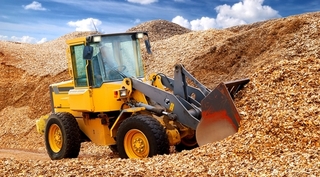 Choosing the right bulldozer dealer is just as important (if not more so) than the actual model you'll select. With that in mind, here are some of the primary benefits of a dealer relationship so you'll know what to expect and be on the lookout for.
Choosing the right bulldozer dealer is just as important (if not more so) than the actual model you'll select. With that in mind, here are some of the primary benefits of a dealer relationship so you'll know what to expect and be on the lookout for.
Training
A bulldozer is not like a tractor or similar small earth moving equipment. There's a little bit of knowledge and expertise that go into operating them well. To operate a bulldozer in most states, you are required to have a standard driver's license and attend a training program that instructs operators on the safe and effective operation of the machine. Often generalized to incorporate all types of bulldozers, these trainings typically address grading techniques as well as information related to different soil types, site layouts, maintenance, and safety.
A good dealer will provide this training, either at their facility or in-house at yours. Those that do not provide the training themselves may partner with a third-party training school.
Maintenance, support, and warranties
This is one of the primary benefits of a dealer relationship as it offers the greatest potential to maximize the return on your investment. In addition to the standard coverage offered by the manufacturer (if you're buying a new machine), the dealer will provide comprehensive plans that address regular service and maintenance, customer support in the event of a breakdown or other problem, and extended warranty coverage.
This all takes shape in a service level agreement (SLA). When comparing dealers, give preference to the one with the most all-inclusive SLA as it represents a solid guarantee on services, response time, and all future costs. For example, a good SLA should include:
- Parts inventory - The specific parts that go into the dozer during maintenance and repairs and that are kept on-hand at the dealer's service facility. This should also include any substitutions if the primary or manufacturer's recommended option is unavailable.
- Service frequency - Establishes the intervals for service including scheduled maintenance (basic), full maintenance (including all operating systems), and comprehensive maintenance (servicing all systems and components). This also details all costs resulting from parts and labor.
- Contact options - Lists customer service options, including live support and online account options. Should include options for after-hours emergencies if the dealer does not provide 24/7 support.
- Response time - This is the turnaround between you contacting customer support and their response - again, especially critical on weekends and holidays if the dealer does not provide 24/7 support.
- On-site service - Though not always included, this is important if your bulldozer needs immediate service. Transporting the machine to the dealer's location or a third-party facility takes time, especially when working on a remote jobsite. Dealers who offer this level of service are a cut about the rest and more than make up for their service fees in the time they save you in turnaround.
Used bulldozer inspection tips
Any used bulldozer you buy from a dealer should come with some type of warranty and guarantee. Many pre-owned models are also eligible for a service agreement as well. But there are a number of inspection tips that should never be overlooked when comparing used bulldozers - no matter how persuasive the warranty or SLA seems. These include:
Get Quotes
- We contact sellers
- They compete for your business
- Leaks - Check the engine and all rams, hoses, and pumps.
- Cracks - Inspect all joints and welded parts such as sprockets, arms, and the tracks and locks for any damage or fissures.
- Undercarriage - Look for dents, cracks, or other damage. Bulldozer undercarriages are designed to be robust, so any significant damage may indicate that the machine has been heavily used.
- Gears - Start the engine and see how the machine responds to changes in forward and reverse motion. Pay attention to squealing or substantial noise as it may indicate faulty rollers.
- Temperature and pressure - Allow the bulldozer to run for at least half an hour and take note of the temperature and pressure. Rising above or dropping below recommended limits may indicate costly repairs are needed.
- Blade and arms - Raise the blade a few inches off the ground then lower it back down, paying attention to the time it takes to offer resistance. The slack between touching the ground and resistance will give you a clear picture of the condition of the arms and pins. Also, pay attention to wear on the blade's cutting edges. Some wear will be normal; cracks and missing chunks are not.
- Service records - If buying a bulldozer through a dealer, they should be able to supply detailed service records. Large gaps in service should serve as a red flag.
